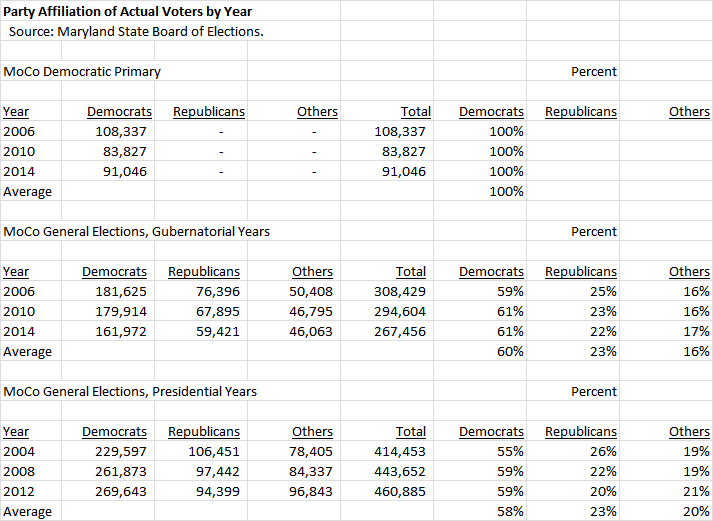By Adam Pagnucco.
Montgomery County voters are some of the most progressive people in the nation. They elect only Democrats, and almost all very liberal ones. They celebrate diversity and respect civil rights. They support a large, active government that passes liberal laws, provides excellent schools and generous social services and has extensive environmental programs. Perhaps most importantly, they are willing to pay the taxes that support all of this.
Is the above a true statement? Yes. And maybe no. It all depends on which electorate you’re talking about. Montgomery County has two of them.
The first electorate is comprised of those Democrats who vote in the closed primaries for County Executive, County Council and members of the General Assembly. Many of these are liberals who vote for candidates with similar views. Indeed, there is an old aphorism that it’s nearly impossible to run too far to the left in MoCo elections. Most elected officials here regard these voters as their political base and tend to be highly responsive to them.
But there is a second electorate: those residents who vote in general elections. These voters come from all political parties and have significant ideological diversity. For the most part, they tend not to reject the nominees of the Democratic Party for local and state office. (The last Republican elected officials here were defeated ten years ago.) But they can and do weigh in on charter amendments and ballot questions, and they do not always behave in accordance with the county’s progressive reputation.
This blog series examines the differences between these two electorates on the eve of the general election, when a landmark ballot question on term limits will be decided. Of the two electorates, only one – the general election voters – will decide whether term limits will pass.
First, we examine the party composition of the two electorates. The Democratic primary voters are of course 100% Democrats since Maryland uses closed primaries. The general election voters are roughly 60% Democratic, slightly more than 20% Republican and slightly less than 20% unaffiliated or members of other parties.

Are liberals a majority of the general electorate? That’s hard to say, but a little math can help. If just a fifth of the Democrats, who comprise 60% of general election voters, are not liberals, then a majority of the general electorate would probably not be liberal. (There are a handful of Green Party members in MoCo, but not enough to change the basic math here.) So while a majority of Democratic primary voters may be liberal, it’s difficult to apply that characterization to the entire electorate.
Another factor that can be easily seen from the data above is the relative size of the electorates. There are about three times as many voters in gubernatorial general elections as there are in gubernatorial Democratic primaries. Presidential general election voters outnumber gubernatorial primary Democrats by five to one. So while Democratic primary voters pick our elected officials, the presidential general voters are a much closer gauge of the political sentiments of the entire community.
We will begin contrasting MoCo’s two electorates in Part Two.
